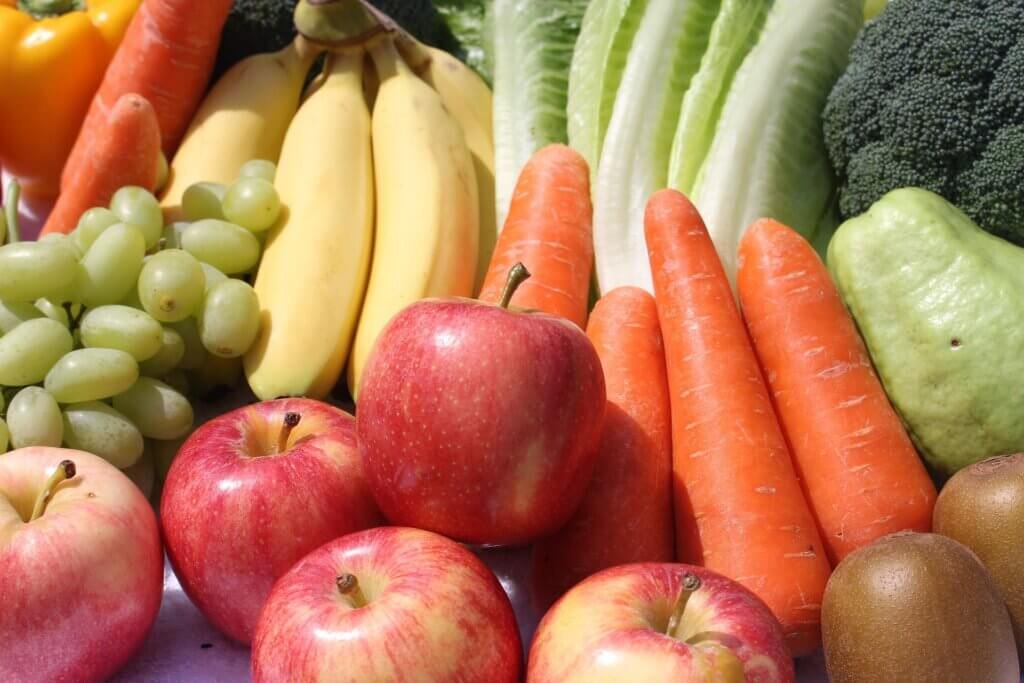People sometimes mix up fruits and vegetables because the distinction can be confusing. Botanically, fruits are the mature ovary of a flowering plant, usually containing seeds, while vegetables are other plant parts like roots, stems, and leaves.
For example, tomatoes, cucumbers, and bell peppers are technically fruits because they develop from the flower of the plant and contain seeds. However, they are commonly used as vegetables in cooking due to their savory flavors. Some plants we think of as vegetables, like rhubarb, are fruits from a botanical standpoint.
Understanding the difference between fruits and vegetables can clarify many culinary and botanical discussions.
Botanically speaking, the primary distinction between fruits and vegetables lies in their plant parts. Fruits are the mature ovary of a flowering plant and typically contain seeds. They develop from the flower of the plant after fertilization.
Examples of botanical fruits include apples, oranges, tomatoes, and cucumbers. Fruits serve as the means for plants to spread their seeds and ensure reproduction. They often have a sweet or tart taste, which helps attract animals that aid in seed dispersal.
On the other hand, vegetables encompass other edible parts of the plant, including roots, stems, and leaves. For instance, carrots are roots, celery is a stem, and spinach and lettuce are leaves. Unlike fruits, vegetables do not develop from the flower of the plant and do not contain seeds. They tend to have a more savory or neutral flavor compared to the sweet or tart taste of most fruits. The term “vegetable” is more about culinary use than botanical classification.
In cooking, the distinction between fruits and vegetables often shifts. Many foods we classify as vegetables in the kitchen, such as bell peppers, cucumbers, and tomatoes, are botanically fruits. This is because they develop from the flowering part of the plant and contain seeds.
The culinary classification typically focuses on flavor profiles and uses rather than botanical definitions. Fruits are commonly used in desserts, snacks, and sweet dishes, while vegetables are more frequently used in savory dishes.
This blending of botanical and culinary classifications can sometimes lead to confusion, but understanding these definitions can help clarify why certain foods are grouped together in different contexts. By appreciating both botanical and culinary perspectives, you can better navigate discussions about fruits and vegetables and assist others in understanding these concepts.
When you are in a store or market, here are some quick ways to distinguish between fruits and vegetables:
Look for Seeds: Botanically, fruits contain seeds. If the produce has seeds or pits inside (like a tomato, bell pepper, or cucumber), it is a fruit. Vegetables, such as carrots, lettuce, and celery, do not contain seeds.
Consider the Plant Part: Think about which part of the plant you are dealing with:
Fruits: Develop from the flower of the plant. Examples include apples, berries, and peppers.
Vegetables: Include other plant parts such as roots (carrots), stems (celery), and leaves (spinach).
Taste and Use: Fruits are often sweet or tart and are used in desserts, snacks, or sweet dishes. Vegetables tend to have a more savory or neutral taste and are used in main dishes, salads, and sides.
Check the Growing Method: Fruits typically grow from the flowering part of the plant and develop from the ovary. If you find produce growing from the flower of the plant (like squash or tomatoes), it is a fruit. Vegetables grow from other parts of the plant and do not involve flowers.
Seasonal and Culinary Context: Sometimes, the culinary classification can give clues. For example, avocados and eggplants are botanically fruits but are used as vegetables in cooking due to their savory flavor.
By applying these guidelines, you can quickly identify whether the produce you are looking at is a fruit or a vegetable.
About Nuts
Nuts are technically considered fruits. Botanically speaking, nuts are a type of fruit known as a “dry fruit.” Specifically, they fall under a category called “indehiscent” fruits, which means they do not split open at maturity to release their seeds.
In a broader sense, a nut is a hard-shelled fruit that contains a single seed. Common examples include acorns, hazelnuts, and chestnuts. However, in culinary contexts, the term “nut” often refers to a variety of seeds and fruits that may not strictly meet the botanical definition. For instance, almonds and cashews are technically seeds from fruits that are not true nuts but are commonly called nuts in cooking and baking.
So, while nuts are technically fruits from a botanical perspective, their culinary usage often blurs the lines between strict botanical definitions and everyday food classifications.
Do not feel bad or dumb if you think fruits only grow on trees and vegetables in the ground.
Many people have similar notions because they are based on common observations and traditional categorizations. Fruits are often associated with trees, and vegetables with plants that grow in the ground, which can simplify the distinction for everyday use. These concepts are practical and make sense in a general sense, even if they do not align perfectly with botanical definitions.
The confusion arises because the botanical and culinary classifications do not always match up neatly. For instance, tomatoes and cucumbers grow on plants, but they are botanically fruits. Similarly, potatoes and carrots grow underground but are considered vegetables.
It is perfectly normal to rely on everyday observations and common knowledge. Understanding the more precise botanical definitions can be helpful, but it does not make your initial understanding incorrect or something to feel bad about. It is all part of learning and gaining more detailed knowledge over time.
In most grocery stores, the produce section is typically organized to help you easily find fruits and vegetables. Here is a general guide to what you might find in each category:
Fruits
- Citrus Fruits: Oranges, lemons, limes, grapefruits.
- Berries: Strawberries, blueberries, raspberries, blackberries.
- Stone Fruits: Apples, peaches, plums, cherries, apricots.
- Tropical Fruits: Bananas, pineapples, mangoes, papayas, kiwis.
- Melons: Watermelons, cantaloupes, honeydews.
- Pome Fruits: Apples, pears.
- Grapes: Both red and green varieties.
Vegetables
- Leafy Greens: Lettuce, spinach, kale, Swiss chard.
- Root Vegetables: Carrots, potatoes, beets, turnips.
- Cruciferous Vegetables: Broccoli, cauliflower, Brussels sprouts, cabbage.
- Legumes: Green beans, peas.
- Bulbs: Onions, garlic, shallots.
- Stems: Celery, asparagus.
- Squash: Zucchini, butternut squash, acorn squash (though some types of squash, like pumpkins, are botanically fruits).
Mixed or Ambiguous Items
- Tomatoes: Botanically fruits but often used as vegetables.
- Cucumbers: Botanically fruits but used as vegetables.
- Bell Peppers: Botanically fruits but used as vegetables.
- Avocados: Botanically fruits but used in savory dishes.
This organization helps you to quickly find what you are looking for and matches the general usage of these items in cooking and meal preparation.
Here is a rundown of common items that often blur the line between fruits and vegetables:
Fruits Often Used as Vegetables
- Tomatoes: Botanically a fruit because they develop from the flower and contain seeds. Culinary use often treats them as a vegetable due to their savory flavor.
- Cucumbers: Also, botanically a fruit. They develop from the flowering part of the plant and contain seeds. In cooking, they are treated as vegetables.
- Bell Peppers: These are fruits botanically, as they contain seeds and develop from the plant’s flower. They are used as vegetables in savory dishes.
- Zucchini: Another fruit botanically, as it grows from the flower and contains seeds, but used as a vegetable in cooking.
- Avocados: Botanically fruits, as they develop from the flower and contain a seed. They are often used in savory dishes, leading to their culinary classification as vegetables.
Vegetables Often Used as Fruits
- Rhubarb: Technically a vegetable because it is the stalk of the plant, but it is used as a fruit in culinary contexts, especially in desserts like pies.
- Pumpkins: Botanically a fruit because they develop from the flower and contain seeds. They are often used as vegetables in savory dishes, though they are also used in sweet recipes.
- Squash: Various types of squash (like butternut and acorn) are botanically fruits due to their seed content and flowering development but are used as vegetables in cooking.
- Sweet Corn: The kernels are botanically seeds and develop from the flower, making corn some fruit. However, it is commonly used as a vegetable.
These examples highlight how culinary practices can differ from botanical classifications, leading to some interesting overlaps and confusion between fruits and vegetables.
Many foods that people commonly think of as vegetables are botanically fruits. This can lead to an interesting situation where people might be consuming more fruits than they realize, even when they think they are eating vegetables.
For instance:
- Tomatoes and bell peppers are often used in savory dishes and salads but are technically fruits.
- Cucumbers and zucchini are also fruits botanically but are used as vegetables in cooking.
- Avocados are another fruit often used in savory dishes and salads.
On the other side, some foods typically used as fruits in cooking, like rhubarb and certain types of squash, are botanically vegetables.
So, it is a fascinating mix where the botanical and culinary classifications do not always align, leading to some surprises about what you are eating!
I hope this information helps clarify the often confusing distinction between fruits and vegetables. Understanding the botanical definitions alongside their culinary uses can provide valuable insights and enhance your knowledge about the foods you eat. Recognizing that many foods commonly thought of as vegetables are technically fruits, and vice versa, might shift your perspective and deepen your appreciation for the diversity of produce. This knowledge can also aid in making informed dietary choices and enrich your discussions about food with others.
If you liked this Share It!
Unleash your BOHOtude – visit BOHOtude Apparel for a selection of free-spirited apparel.











